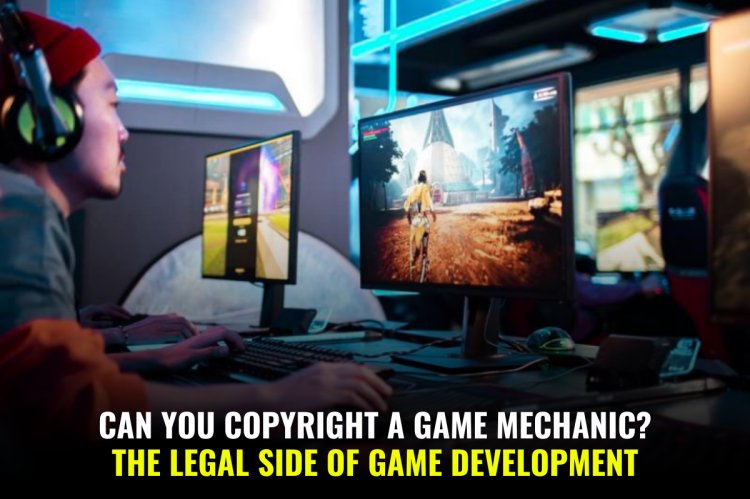Can You Copyright a Game Mechanic? The Legal Side of Game Development
Understanding intellectual property (IP) laws is essential for game developers looking to protect their work. One of the most debated aspects of game development is whether game mechanics can be copyrighted. While copyright law safeguards creative expressions such as storylines, characters, and software code, it does not extend to game mechanics. This blog delves into what copyright covers in video games, why mechanics are excluded from protection, and alternative legal measures—such as patents, trademarks, and contracts—that developers can use. By examining famous legal cases and best practices, this article provides a comprehensive guide to navigating the legal landscape of game development.

Introduction
Game development is an exciting yet complex field that blends creativity with technical expertise. However, a crucial aspect of game creation that often leads to confusion is intellectual property (IP) law. One of the most frequently asked questions in this domain is: Can you copyright a game mechanic? The answer is more nuanced than a simple yes or no.
Understanding the legal landscape of game mechanics is essential for game developers who want to protect their work. In this blog, we will explore what copyright covers in game development, why game mechanics are not protected under copyright law, and alternative legal strategies that can safeguard game mechanics from unauthorized use.
Understanding Copyright in Game Development
What is Copyright?
Copyright law protects original works of authorship, ensuring that creators have exclusive rights to their creations. This applies to various forms of intellectual property, including literary, artistic, and musical works.
What Does Copyright Protect in Video Games?
In the context of video games, copyright can be applied to:
- The game's story, script, and dialogue
- Original characters and their unique designs
- Visual elements such as artwork, graphics, and animations
- Soundtracks and sound effects
- Software code that makes the game function
What Is Not Protected by Copyright?
Copyright law does not extend to ideas, methods, systems, or functional aspects of a creation. This means that game mechanics—such as rules, procedures, and systems—are not protected under copyright law.
Why Can’t You Copyright a Game Mechanic?
Game mechanics fall under the category of functional systems, which are excluded from copyright protection. Copyright law is designed to protect the expression of an idea, not the idea itself. Since game mechanics function as rules of play, they are considered an unprotectable system rather than a creative expression.
Examples of Unprotected Game Mechanics
- The concept of jumping over obstacles to avoid enemies (Super Mario Bros.).
- The idea of turn-based combat in RPGs.
- The battle royale format (popularized by PUBG and Fortnite).
These mechanics are considered universal gameplay elements that any developer can use and adapt in different ways.
To know more about this you can follow the link below:
Alternative Legal Protections for Game Mechanics
Although copyright does not cover game mechanics, other legal avenues exist to protect them:
1. Patents
A utility patent can protect a unique game mechanic if it meets the criteria of being novel, non-obvious, and useful.
- Example: Namco patented the concept of loading screen mini-games, preventing competitors from using the idea without permission.
- Downside: Patents are expensive and take years to obtain, making them impractical for many indie developers.
2. Trademarks
If a game mechanic is closely tied to a unique brand or name, it may be protected under trademark law.
- Example: The term Bullet Time (popularized in Max Payne) was trademarked, preventing competitors from using the name, even if they implemented a similar slow-motion mechanic.
- Limitation: Trademarks protect the name and branding, not the underlying mechanic.
3. Contracts and Licensing
Developers can use contractual agreements to protect their work:
- Non-Disclosure Agreements (NDAs): Prevent team members or collaborators from revealing game mechanics before release.
- Licensing Agreements: Allow third parties to use proprietary mechanics under specific terms.
Famous Legal Battles Over Game Mechanics
Several high-profile legal disputes have tested the boundaries of IP protection in gaming:
1. Capcom vs. Data East (Street Fighter II vs. Fighter’s History)
- Capcom sued Data East, claiming Fighter’s History copied Street Fighter II's mechanics.
- Court ruling: Mechanics are not copyrightable; Data East won.
2. Tetris Holding vs. Xio Interactive
- Xio Interactive created Mino, a game that closely resembled Tetris in visual design and grid layout.
- Court ruling: Tetris Holding won because the expression (visual elements, colors, and UI) was copied, not just the mechanics.
3. PUBG Corp vs. Epic Games (PUBG vs. Fortnite)
- PUBG Corp filed a lawsuit against Epic Games, alleging that Fortnite copied its battle royale format.
- Outcome: The lawsuit was withdrawn before a legal ruling was made, leaving the issue unresolved.
Best Practices for Protecting Your Game
Since game mechanics cannot be copyrighted, developers should focus on other strategies:
- Create a distinctive style and branding around mechanics (e.g., unique UI, animations, and themes).
- Innovate and improve upon existing mechanics rather than relying on legal protections.
- Use trademarks and patents strategically, if financially viable.
- Leverage early access and strong marketing to establish a first-mover advantage.
Conclusion
While game mechanics themselves are not protected by copyright, other legal tools such as patents, trademarks, and contracts can help developers protect their work. Understanding the legal side of game development is crucial to ensuring that your creativity and hard work remain secure in an industry where inspiration often leads to iteration.
By focusing on innovation, branding, and strategic protection methods, developers can create successful games without relying on copyright to safeguard mechanics. Ultimately, the best protection is a combination of legal awareness and creative execution.












